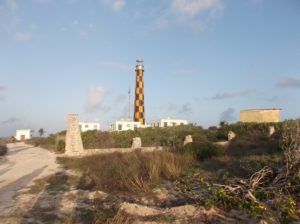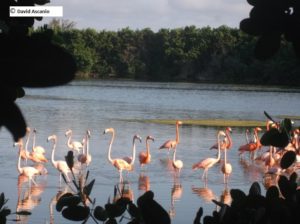Locale: On 26 July 1988 the causeway linking to Cayo Coco with the mainland was completed. Here is more information about this project that I found on the Internet:
The causeway linking Cayo Coco to the mainland is 17 miles long and runs across Perros Bay. It took 16 months to build and required 110 million cubic feet of stone. The causeway caused concern among environmentalists because it disturbed the tidal flow, thus changing the salinity and temperature of the water. A number of gaps were created in the causeway to restore some water flow. Wild flamingos still live in the shallow waters of the bay and can often be seen from the causeway, albeit less frequently. Two short causeways link Cayo Coco to Cayo Guillermo to the west and Cayo Romano to the east.
This article also says that “coco” refers to the white ibis; supposedly the locals call them the “coconut birds.”
Weather: 80s. Sunny.
Itinerary: Cayo Coco to Cayo Guillermo and back
Overnight: Hotel Sol Cayo Coco, Jardines del Rey
Excursions: Buffet breakfast at 6:30, birding at Cayo Paredón Grande near the lighthouse, buffet lunch at hotel, birding at Cayo Guillermo, birding at Las Coloradas Beach, buffet dinner at hotel
Habitats: Desert scrub, sandy beach, coastal wetlands, mudflats, mangroves.
Bird Species (partial listing, by family): West Indian Whistling Duck (Dendrocygna arborea), Blue-Winged Teal (Anas discors), Northern Shoveler (Anas clypeata), American Flamingo (Phoenicopterus ruber), Cuban Emerald Hummingbird (Chlorostilbon ricordii), Common Gallinule (Gallinula galeata), Black-Necked Stilt (Himantopus mexicanus), Semipalmated Plover (Charadrius semipalmatus), Piping Plover (Charadrius melodus), Killdeer (Charadrius vociferus), Ring-Billed Gull (Larus delawarensis), Lesser Black-Backed Gull (Larus fuscus), Caspian Tern (Hydroprogne caspia), Magnificent Frigatebird (Fregata magnificens), Double-crested Cormorant (Phalacrocorax auritus), Great Blue Heron (Ardea herodias), Great Egret (Ardea alba), Snowy Egret (Egretta thula), Little Blue Heron (Egretta caerulea), Tricolored Heron (Egretta tricolor), Roseate Spoonbill (Platalea ajaja), Cuban Black Hawk (Buteogallus gundlachii), Belted Kingfisher (Megaceryle alcyon), Yellow-Bellied Sapsucker (Sphyrapicus varius), Thick-Billed Vireo (Vireo crassirostris), Cuban Gnatcatcher (Polioptila lembeyei), Bahama Mockingbird (Mimus gundlachii), Western Spindalis (Spindalis zena), Zapata Sparrow (Torreornis inexpectata)
Other species: Barracuda, juvenile (Sphyraena)
Guides and Driver: Angel, David, Liu, Odey and Carlos
Observations: Marti and I swam in both the hotel pool in the late morning and in the ocean in the early afternoon.
Reflections: I borrowed a field guide from the UMass Library: A Field Guide to the Birds of Cuba by Orlando Garrido and Arturo Kirkconnell. It’s hard-bound so a bit heavy, but I’m taking it with me every day, as I believe it will be quite useful.
Images:

We are birding at Cayo Paredón Grande.

We observed these West Indian Whistling Ducks in a King’s Gardens resort.

This statue of writer Ernest Hemingway welcomes tourists to where he used to fish.

The vibrant pinks of these flamingos are attributed to their diet.

